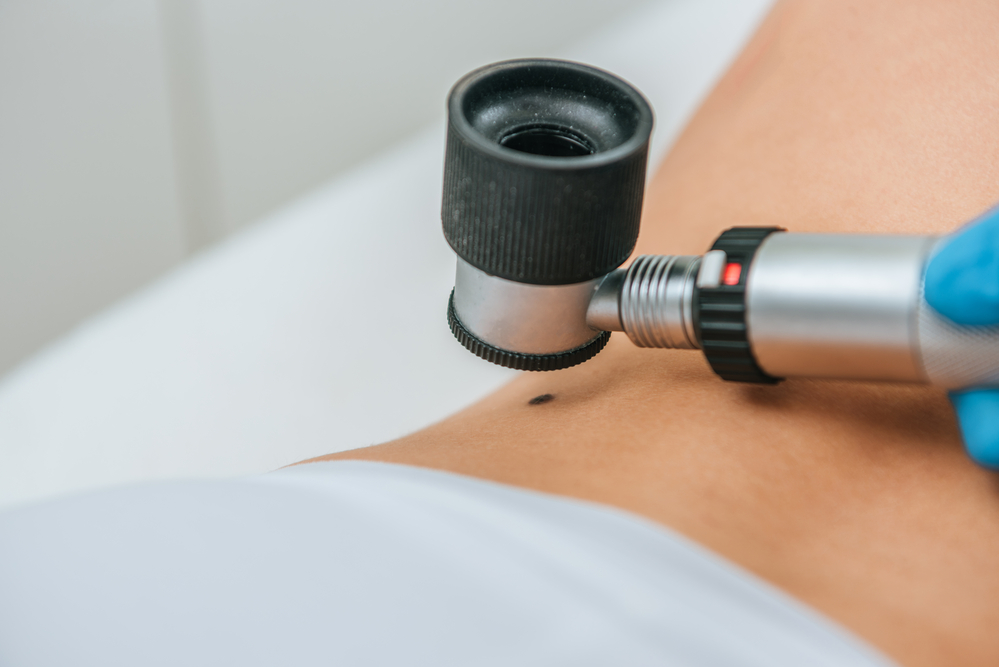According to the American Academy of Dermatology, 1% of Americans are born with at least one mole. Most of the other 99% of Americans develop at least one mole over the course of their life. If you have a mole in an awkward place that rubs against your clothing and hurts you, consider mole removal at the Dermatology Center of Acadiana in Lafayette, LA.
Our board-certified dermatologists have decades of experience with mole removal. We can even identify by sight if a mole is dangerous and needs to be removed immediately. If you’re on the fence about having your mole or moles removed, we’d like to help you make an informed decision by answering the most frequently asked questions about mole removal.
Mole Removal FAQs
How Dermatologists Do Mole Removal?
By far, the most frequently asked question we get about mole removal is how do dermatologists remove moles. There are several methods dermatologists use to remove moles. The method we will use for you depends on your unique case. The most common techniques used to remove moles include surgical excision, punch excision, and shave excision.
What Does Surgical Excision Involve?
Surgical excision starts just like all our other mole removal techniques. The affected area will be cleansed with an alcohol-based antiseptic and a local anesthetic will be injected to numb the region. Then, the entire mole is cut out all the way down to the subcutaneous fat layer.
Because we go deeper with a surgical excision than a shave excision, the incision will be closed with biodegradable stitches. This means that your skin will absorb the stitches and you will not need to come in for a follow-up appointment to have the stitches removed. The excised mole will be tested for the presence of cancer cells, and we will call you with the results.
What Does Shave Excision Involve?
Shave excision is similar to surgical excision in that we use a thin, razor-like tool to remove the mole carefully. So the excision is not evident, we use a technique known as feathering that blends the edges of the location the mole was removed from with the surrounding skin. It looks so seamless that even dermatologists will have trouble identifying where a mole was removed from.
Because we do not slice as deeply during shave excisions as surgical excisions, there is no need for stitches. If your mole is atypical or there are other signs you may have skin cancer, we will examine the mole under a microscope to check for precancerous or cancerous cells.
What Does Punch Excision Involve?
Punch excisions involve the use of a small tool with a round blade. This blade applies pressure to the mole. When the tool is pulled out, the mole is removed. This technique usually requires only one to two stitches depending on the size of the mole. Again, these stitches are biodegradable so you will not need a follow-up appointment.
Punch excisions involve deeper penetration than shave excisions but shallower penetration than surgical excisions. There is no extensive preparation, and there is no recovery period other than avoiding extreme heat for 24 hours after your mole removal.
Do I Need My Mole Removed?
It seems that today more than ever people are keeping their moles. We wholeheartedly believe that everyone should be confident in his or her appearance. But moles aren’t just a cosmetic issue. They can indicate or cause a skin problem. Sometimes, moles are benign and may be left alone.
However, it is important that you come in for an initial consultation or schedule a virtual consultation to verify that your mole is benign and does not need to be removed. With two convenient locations in Breaux Bridge in St. Martin Parish and Lafayette in Lafayette Parish, you have no excuse to not get your mole checked out. It could save your life.
When Do I Need My Mole Removed?
When determining if your mole needs to be removed, we look at the “ABCDEs” of the mole. The five characteristics we look at are Asymmetry, Border, Color, Diameter, and Evolution. If the sides of the mole are not uniform, there is a very high possibility of melanoma, and, at the very least, a biopsy needs to occur to diagnose or rule out cancer.
Another sign of melanoma is poorly defined or irregular borders. If one mole has several colors, you need to come in for a consultation right away. This is an indicator of a significant problem that needs to be addressed immediately. A mole with a diameter of over 6 mm is another risk factor of melanoma. Finally, evolution (changing in size or color) can indicate a problem.
How Are Moles Diagnosed?
At the Dermatology Center of Acadiana, our board-certified dermatologists have the education and experience to identify a type of mole by sight and tell if it may be cancerous. If a mole looks like it is precancerous or cancerous, it will be removed and biopsied. The results of the biopsy will reveal if the mole is benign, atypical, or malignant.
Watch the area the mole was removed from. If the mole was atypical and it grows back, you may have skin cancer. If this occurs, please reach out to us right away so we can discuss your options.
What Type of Mole Do I Have?
If you were not born with a mole, you most likely have a type of mole known as a common mole. Moles that appear after birth are also known as acquired moles, and they are usually neither precancerous nor cancerous. The fairer your skin is, the more likely you will develop common moles throughout your lifetime.
People with light skin typically develop between 10 and 40 moles over the course of their life. People with darker skin tend to have two to five moles develop over the years. If you have 50 or more moles, you are at a much higher risk of having melanoma.
What Other Types of Moles Are There?
Other types of moles include atypical moles, congenital moles, and spitz nevus moles. Spitz nevi are usually pink, raised, dome-shaped moles that resemble melanoma so closely that they need to be diagnosed. They usually grow within the first 20 years of life. However, they do develop later in life in rare cases.
While most Spitz nevi are pink, they can also be red, black, or brown. These moles typically bleed and may also have an opening that oozes. Congenital moles are moles that individuals are born with. They can vary in size from tiny to huge. The larger a congenital mole is, the greater the risk of developing melanoma in the future.
What About Atypical Moles?
Atypical moles are another type of mole that may resemble melanoma. However, they are not melanoma. You are at a much higher risk of developing melanoma if you have no fewer than four atypical moles, a history of melanoma or a parent, sibling, or child who had melanoma. Atypical moles are also known as dysplastic nevi.
Dysplastic nevi are typically larger than 6 mm in diameter, rarely round, and often feature several colors. For example, it is not uncommon to see an atypical mole that is both tan and brown or pink and red. These moles may appear anywhere on the body. However, they more commonly appear on the trunk, scalp, head, or neck than the face.
Is My Child at Risk of Developing Atypical Moles?
If your parent and you both have developed multiple atypical moles, your child is at risk of developing FAMMM (familial atypical multiple mole-melanoma) syndrome. People who suffer from FAMMM syndrome have a blood relative with active melanoma or a history of melanoma. They have over 50 moles, and some of these moles are atypical.
If My Mole Is Only One Color, Do I Still Need to Come in?
Multi-colored moles are only one potential sign of melanoma. If your mole exhibits even one of the other risk factors of melanoma, it is of the utmost importance that you come in for an initial consultation. Skin cancer treatment is more effective the earlier it is caught.
If you have skin cancer and it goes diagnosed for long enough, it can penetrate deeper into the skin. If it penetrates your skin deeply enough, it can even spread to other organs. If a first-degree blood relative, such as a parent or sibling, has ever been diagnosed with melanoma, you are at a higher risk of also developing it and it is even more important to come in.
What Is Melanoma?
Melanoma is the most serious type of skin cancer a person can have. It occurs when melanocytes grow out of control and this type of skin cancer is the most likely to spread to other types of your body. Because melanocytes are the skin cells that give your skin its tan or brown color, melanoma cells are typically brown or black.
However, in some cases, melanomas do not make melanin. Such cells will be white, tan, or pink. While they can develop anywhere, they usually first develop on the chest and back of men and legs of women. Both sexes experience melanoma on the neck and face at equal rates. Other common locations of melanoma include:
- The palms of the hands
- The soles of the feet
- Under the nails
Should I Be Concerned About Skin Changes in My Genital Region?
Less common locations for melanoma to develop include the genitals, anal region, eyes, and mouth. However, melanoma can start anywhere and spread anywhere. If your OBGYN or physician has noticed a change in your skin around your genitals or anal region, it may be a sign of melanoma, particularly if your skin has gotten darker.
If you notice any change in your skin, be it mole growths or significant changes in color, we strongly encourage you to come in for an evaluation. In the United States alone, over two people die of skin cancer every hour. When diagnosed early, it can be treated. Don’t leave your life to chance.
Invest in a New You Today
Moles don’t just pose a cosmetic problem. They could also be an indication or cause of a medical one. Mole removal is quick, painless, and can save you thousands of dollars in the future. To learn more about the techniques we use to remove moles and discover which technique is right for you, please contact us today at the Dermatology Center of Acadiana in Lafayette, LA.
We are more than happy for you to come in for an initial consultation so we can evaluate the size and shape of your mole and talk to you in person. Or, if you’d prefer, we are pleased about the opportunity to provide you with a virtual consultation. Just call the Dermatology Center of Acadiana in Lafayette, LA at (337) 210-7381 and let us know your preference when you schedule.

